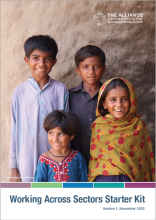
Food Security and Child Protection
Key resources developed by Alliance member organizations and relevant guidance included in the Child Protection Minimum Standards.

Children are disproportionately affected by humanitarian crises. They are a distinct group from adults, with unique needs and capacities that vary by age, gender, ability, legal status, and other individual characteristics. The centrality of children and their protection in humanitarian action is a...

The whole humanitarian system has a role to play in realising children’s rights, including their right to protection. Greater collaboration, action, and investment are needed to ensure all humanitarian interventions are safe, accessible, and child protection sensitive. When protecting children is a...

Working effectively across sectors for children’s protection and well-being requires building relationships and collaboration with sectors like health, education, food security and camp coordination and camp management. Child protection actors need to understand other sectors’ approaches, priorities...

The importance of collaboration between Child Protection and Food Security actors in humanitarian settings cannot be overestimated. For instance, jointly planned programs in the same locations can help mitigate the impact of food insecurity on children’s protection.
This collaboration works both...
Standard: All children affected by humanitarian crises live in food secure environments that mitigate and respond to child protection risks.

On October 31st, the Alliance, alongside the Global Child Protection Area of Responsibility, the Global Food Security Cluster and Plan International, organized a global online event to spotlight how food security impacts children and their protection in humanitarian contexts and recommendations for...
- 839 views
